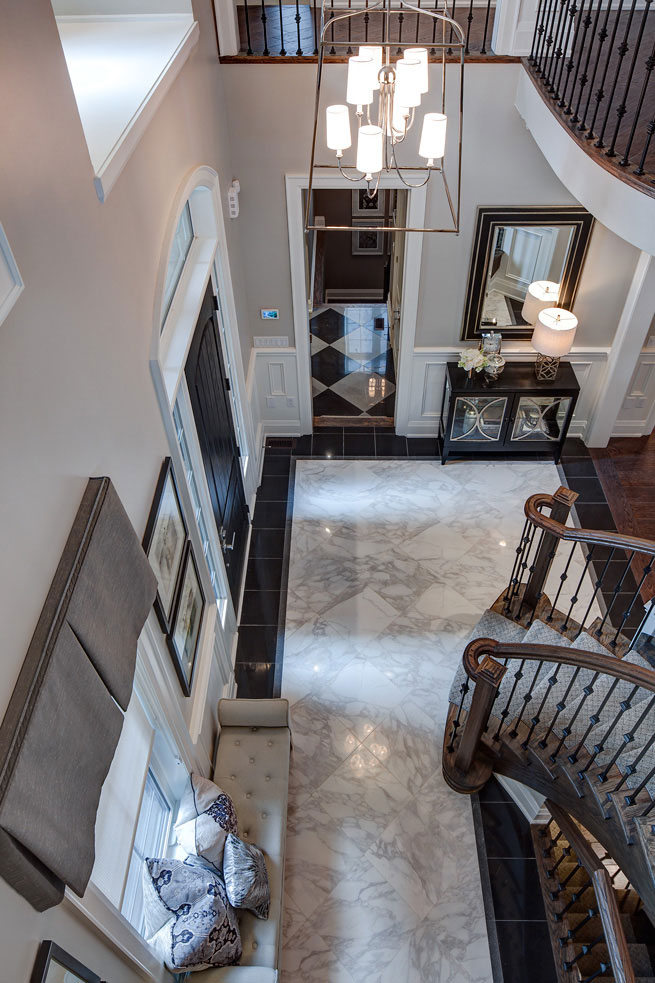For most homeowners there is always “something more to do…” when it comes to updating and maintaining their house on a regular basis. So, when it’s time to update some part of your home’s interior, stretching those renovation dollars becomes paramount.

Enhance your renovation without spending a lot
As a designer, clients often ask how they can enhance their renovation, maximizing its visual appeal while minimizing the financial impact in the end? I guess the question really becomes: Are there specific or key design details worth adding when you already have a tight budget and timeline? The answer to this is yes, as small design details can make a ho-hum renovation look a lot more impressive!
Porcelain tile
To begin, if you are doing any tile work throughout the house, whether it’s a bathroom, mudroom or front hall, select a well-priced porcelain tile. Porcelain tiles are heavier and fired at a higher temperature than ceramic, making them more durable overall. Today, it’s fairly easy to find tile at a really good price and using a design trick, make it look amazing. Simply add in a tile insert of contrasting small 2” by 2” tiles within the larger tile layout, defining the area and making a feature within a plain tile field. This addition to a front foyer, for instance, makes an impressive entrance and makes a cheaper tile look more expensive.

Large tiles and patterns
Sticking with tile, installing larger tiles in different patterns, such as on the diagonal or in a herringbone direction rather than simply straight looks more upscale. It does cost more to do, as there is additional tile waste and more time involved but this elevates the ordinary to the extraordinary when working on floors.
Wall detail and wainscoting
Another design detail that can make a difference is addressing plain walls. To add more interest to a long hallway or master bedroom, try adding small molding in large rectangles across the entire wall surface. Using trim molding about 1.5” wide to form large wall rectangles can make the ceiling look higher and walls more detailed. Purchase this at the local building center, nail and glue in place, and paint the applied trim molding and wall in the same colour. Or purchase the premade trim squares to create the look of wainscoting, available as a kit, also from building centers. Wall detail and wainscoting both add visual value and impact to a room without too much hassle or cost.
Ceiling medallions
Ceiling medallions, a round or oval decorative disk added to the canopy or ceiling mount of a hanging light fixture, can make a more traditional space look finished. These items can be purchased at numerous home décor centers, are made of a coated hard foam, and are installed with construction adhesive and a screw to hold while drying. This is a low cost item and worth the expense as it finishes the room and adds visual height.
Interior doors and door hardware
Another design detail worth the effort is upgrading either interior doors or the door hardware. The ordinary six-panel “colonial” style door costs the same as a version that is two or three panels but which looks much more custom. And door hardware can add a lot of zing, as everyone comes into contact with it at some point! Select a more interesting shape or higher contrast colour like oil rubbed bronze to draw attention to this decorative feature. This is like jewelry for your home, so combining a basic door design with unique hardware ups the perceived value of your interior.
Small details can change your overall impression of a house
Although many argue that the details don’t matter, they actually do. It may not be that everyone notices each detail immediately when perusing your newly renovated home. But, the secret of good design lies in how a room feels overall. Well-chosen and “strategically placed” details change our perception of a house and this in turn, changes our impression of it, whether to make it feel more custom, more beautiful or more expensive.
This doesn’t mean spending on every detail unless you have the time and money to do so, but ignoring the opportunity to add in a few special elements may mean you miss the chance to turn your house into a home.

